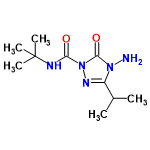amicarbazone C10H19N5O2 structure – Flashcards
Flashcard maker : Jay Barber

| Molecular Formula | C10H19N5O2 |
| Average mass | 241.290 Da |
| Density | 1.3±0.1 g/cm3 |
| Boiling Point | |
| Flash Point | |
| Molar Refractivity | 63.3±0.5 cm3 |
| Polarizability | 25.1±0.5 10-24cm3 |
| Surface Tension | 45.4±7.0 dyne/cm |
| Molar Volume | 188.5±7.0 cm3 |
- Experimental data
- Predicted – ACD/Labs
- Predicted – EPISuite
- Predicted – ChemAxon
- Experimental Physico-chemical Properties
- Miscellaneous
Predicted data is generated using the ACD/Labs Percepta Platform – PhysChem Module
| Density: | 1.3±0.1 g/cm3 |
| Boiling Point: | |
| Vapour Pressure: | |
| Enthalpy of Vaporization: | |
| Flash Point: | |
| Index of Refraction: | 1.587 |
| Molar Refractivity: | 63.3±0.5 cm3 |
| #H bond acceptors: | 7 |
| #H bond donors: | 3 |
| #Freely Rotating Bonds: | 2 |
| #Rule of 5 Violations: | 0 |
| ACD/LogP: | -0.99 |
| ACD/LogD (pH 5.5): | 0.27 |
| ACD/BCF (pH 5.5): | 1.00 |
| ACD/KOC (pH 5.5): | 33.45 |
| ACD/LogD (pH 7.4): | 0.27 |
| ACD/BCF (pH 7.4): | 1.00 |
| ACD/KOC (pH 7.4): | 33.45 |
| Polar Surface Area: | 91 Å2 |
| Polarizability: | 25.1±0.5 10-24cm3 |
| Surface Tension: | 45.4±7.0 dyne/cm |
| Molar Volume: | 188.5±7.0 cm3 |
Predicted data is generated using the US Environmental Protection Agency’s EPISuite™
Log Octanol-Water Partition Coef (SRC): Log Kow (KOWWIN v1.67 estimate) = 1.24 Boiling Pt, Melting Pt, Vapor Pressure Estimations (MPBPWIN v1.42): Boiling Pt (deg C): 423.22 (Adapted Stein & Brown method) Melting Pt (deg C): 176.73 (Mean or Weighted MP) VP(mm Hg,25 deg C): 5.99E-008 (Modified Grain method) Subcooled liquid VP: 2.25E-006 mm Hg (25 deg C, Mod-Grain method) Water Solubility Estimate from Log Kow (WSKOW v1.41): Water Solubility at 25 deg C (mg/L): 2287 log Kow used: 1.24 (estimated) no-melting pt equation used Water Sol Estimate from Fragments: Wat Sol (v1.01 est) = 924.01 mg/L ECOSAR Class Program (ECOSAR v0.99h): Class(es) found: Hydrazines Imides Henrys Law Constant (25 deg C) [HENRYWIN v3.10]: Bond Method : 1.98E-014 atm-m3/mole Group Method: Incomplete Henrys LC [VP/WSol estimate using EPI values]: 8.316E-012 atm-m3/mole Log Octanol-Air Partition Coefficient (25 deg C) [KOAWIN v1.10]: Log Kow used: 1.24 (KowWin est) Log Kaw used: -12.092 (HenryWin est) Log Koa (KOAWIN v1.10 estimate): 13.332 Log Koa (experimental database): None Probability of Rapid Biodegradation (BIOWIN v4.10): Biowin1 (Linear Model) : 0.4487 Biowin2 (Non-Linear Model) : 0.1052 Expert Survey Biodegradation Results: Biowin3 (Ultimate Survey Model): 2.4538 (weeks-months) Biowin4 (Primary Survey Model) : 3.3462 (days-weeks ) MITI Biodegradation Probability: Biowin5 (MITI Linear Model) : -0.3597 Biowin6 (MITI Non-Linear Model): 0.0000 Anaerobic Biodegradation Probability: Biowin7 (Anaerobic Linear Model): -0.0619 Ready Biodegradability Prediction: NO Hydrocarbon Biodegradation (BioHCwin v1.01): Structure incompatible with current estimation method! Sorption to aerosols (25 Dec C)[AEROWIN v1.00]: Vapor pressure (liquid/subcooled): 0.0003 Pa (2.25E-006 mm Hg) Log Koa (Koawin est ): 13.332 Kp (particle/gas partition coef. (m3/ug)): Mackay model : 0.01 Octanol/air (Koa) model: 5.27 Fraction sorbed to airborne particulates (phi): Junge-Pankow model : 0.265 Mackay model : 0.444 Octanol/air (Koa) model: 0.998 Atmospheric Oxidation (25 deg C) [AopWin v1.92]: Hydroxyl Radicals Reaction: OVERALL OH Rate Constant = 6.2226 E-12 cm3/molecule-sec Half-Life = 1.719 Days (12-hr day; 1.5E6 OH/cm3) Half-Life = 20.627 Hrs Ozone Reaction: No Ozone Reaction Estimation Fraction sorbed to airborne particulates (phi): 0.355 (Junge,Mackay) Note: the sorbed fraction may be resistant to atmospheric oxidation Soil Adsorption Coefficient (PCKOCWIN v1.66): Koc : 387.8 Log Koc: 2.589 Aqueous Base/Acid-Catalyzed Hydrolysis (25 deg C) [HYDROWIN v1.67]: Rate constants can NOT be estimated for this structure! Bioaccumulation Estimates from Log Kow (BCFWIN v2.17): Log BCF from regression-based method = 0.258 (BCF = 1.812) log Kow used: 1.24 (estimated) Volatilization from Water: Henry LC: 1.98E-014 atm-m3/mole (estimated by Bond SAR Method) Half-Life from Model River: 4.593E+010 hours (1.914E+009 days) Half-Life from Model Lake : 5.011E+011 hours (2.088E+010 days) Removal In Wastewater Treatment: Total removal: 1.92 percent Total biodegradation: 0.09 percent Total sludge adsorption: 1.82 percent Total to Air: 0.00 percent (using 10000 hr Bio P,A,S) Level III Fugacity Model: Mass Amount Half-Life Emissions (percent) (hr) (kg/hr) Air 3.6e-007 41.3 1000 Water 37.4 900 1000 Soil 62.5 1.8e+003 1000 Sediment 0.0843 8.1e+003 0 Persistence Time: 1.11e+003 hr
Click to predict properties on the Chemicalize site


